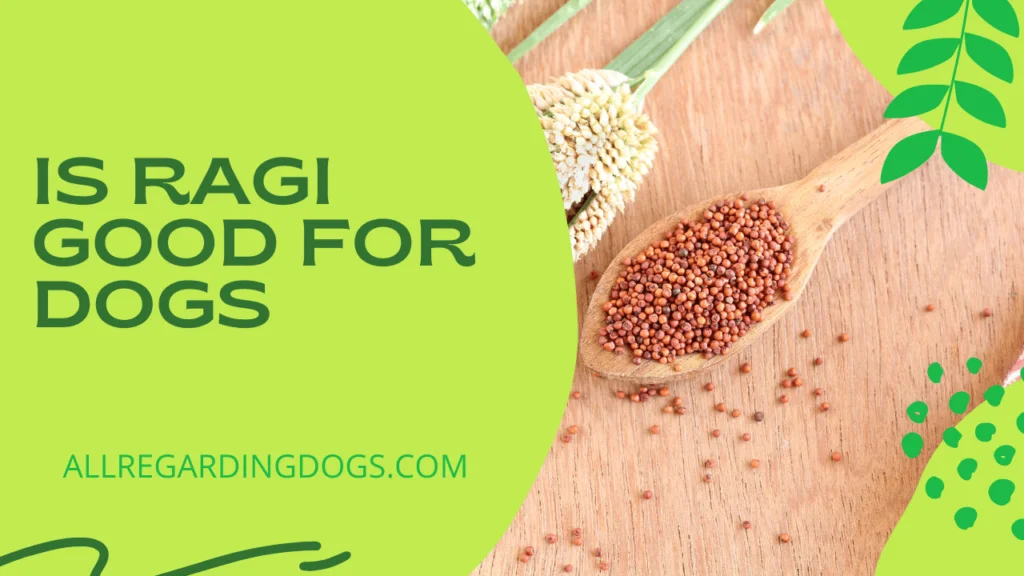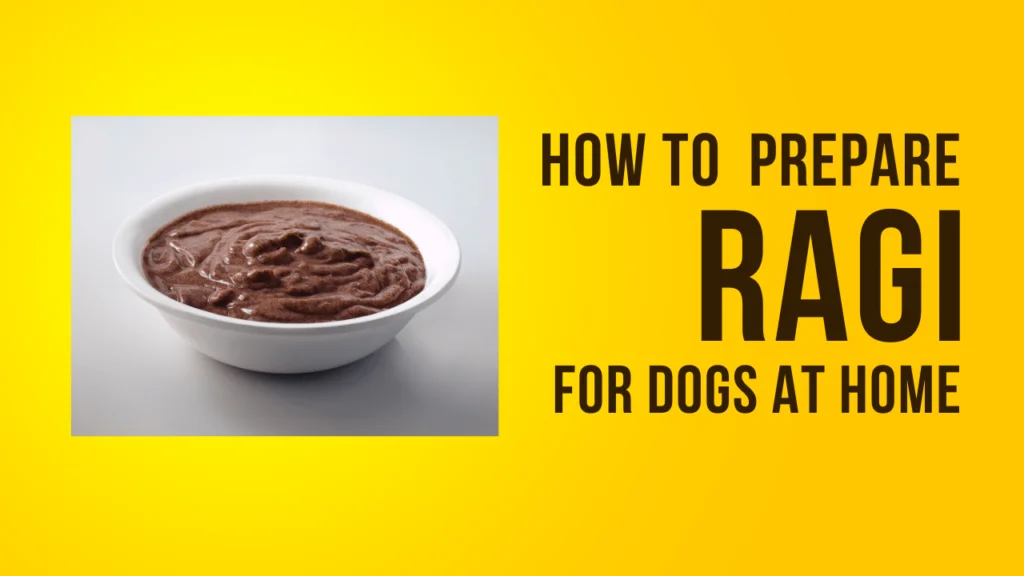Can dogs eat Ragi? Ragi for dogs.
Yes, dogs can eat Ragi without any harm. Ragi can be dog-friendly and makes a fantastic food for dogs. It has to be appropriately prepared and cooked, and it should be served in shape in the form of porridge. In addition, it must be served in moderate amounts and on certain appropriate occasions.
Ragi can be described as Ragi, the Indian term used to refer to Finger millet(Eleusine coracana). In Nepal, the millet is called Kodo. Ragi is very nutritious and contains various vitamins, minerals, and phytonutrients.
Is Ragi good for Dogs?

Ragi is full of nutrition and is readily accessible. Additionally, it’s easy to make, and canines enjoy its flavor. It can also be mixed with other dog-friendly meals and is served in various meals. Let’s look at the main reasons ragi are good for dogs.
Finger millet is considered one of the most nutritious cereals. Finger millet contains about 5–8% protein, 1–2% ether extractives, 65–75% carbohydrates, 15–20% dietary fiber and 2.5–3.5% minerals. Of all the cereals and millets, finger millet has the highest amount of calcium (344mg%) and potassium (408mg%). The cereal has low fat content (1.3%) and contains mainly unsaturated fat. 100 grams of Finger millet has roughly on an average of 336 KCal of energy in them.
However, the millet also contains phytates (0.48%), polyphenols, tannins (0.61%), trypsin inhibitory factors, and dietary fiber, which were once considered as “anti nutrients” due to their metal chelating and enzyme inhibition activities (Thompson 1993) but nowadays they are termed as neutraceuticals.Being non-glutinous, finger millet is safe for people suffering from gluten allergy and celiac disease. It is non-acid forming, and hence easy to digest. Finger millet is rich in amino acids (Tryptophan, Threonine, Valine, Isoleucine and Methionoine).
Nutritional value of Ragi
Gluten-Free Grain
Ragi is one of the gluten-free grains that are gluten-free. ; therefore, Ragi is safe for dogs with gluten-related sensitivities and sensitivities.
Rich in Dietary Fiber
Ragi is rich in fiber in the diet and prebiotics. Prebiotics are vital for regular digestion as well as regular stool movement. They also help maintain cardiovascular health and assist in keeping levels of blood sugar and cholesterol levels within a healthy range.
Aids in Diabetes
Ragi has a variety of nutrients that can help control blood sugar levels, making Ragi the ideal choice for dog owners with diabetes. The nutrients that improve blood sugar levels include dietary fiber, minerals, amino acids, and polyphenols.
Aids in Weight Loss
Due to the high in dietary fiber, Ragi is a great food to help lose weight. For instance, high-fiber diets aid digestion and help your Dog feel full for more extended periods.
Helps Promote Skin & Coat Health
Ragi contains several amino acids, including lysine and methionine. The amino acids in Ragi are crucial to maintaining good skin and a shiny coat.
Combats Anemia
Ragi is a source of iron that boosts hemoglobin concentrations and assists with anemia. The sprouted ragi varieties are filled with vitamins C. Vitamin C enhances the body’s capacity to absorb hemoglobin.
Enhances Bone Strength
Ragi is especially abundant in calcium, the primary mineral for promoting solid bone and teeth. In reality, regarding calcium levels, Ragi are considered comparable to milk products.
Can Ragi be bad for Dogs?
Yes, Ragi isn’t the best choice for dogs. In reality, any human’s food could destroy a dog’s digestive system in the event of misuse.
Ragi is very high in carbohydrates and grain, which means it’s not part of a dog’s diet. Therefore, it can be dangerous when consumed over (too often or often). Here are some reasons why Ragi could be harmful to dogs.
Indigestion
Ragi consumption can cause gastric upset in dogs. Some dogs have more sensitive stomachs and experience indigestion even if they are fed normal quantities of Ragi. The possibility of stomach upsets is higher when eating raw ragi that have not been cooked.
Too Many Carbs
Ragi has a reputation for being high in carbohydrates. Ragi may cause problems such as energy surges (hyperactivity), dental decay, diabetes, and weight gain if consumed in large quantities.
Allergic Reactions
Certain dogs may be susceptible to the irritants of grains. While the likelihood of an allergic reaction to ragi is not high, there is always a possibility. Allergies to food in dogs can manifest as vomiting, stomach pain, gassiness, and itching.
How Much Ragi can my Dog eat?
Ragi is classified as an edible treat and therefore shouldn’t comprise more significant than 10 percent of a dog’s daily diet. Ideally, you should give a moderate-sized pet approximately 4 to 5 tablespoons of well-cooked ragi.
Larger dogs may consume more food than this, and smaller dogs need to eat less. For the frequency of food consumption, you should restrict your serving to every week. Ragi is suitable for puppies if they can digest it correctly.
To prevent undesirable reactions and adverse side effects to avoid unwanted reactions and side effects, we recommend giving your Dog one bit or two of the ragi before serving it for the initial time. If there is no sign of discomfort, gradually increase the amount until you reach an amount considered appropriate.
How to prepare Ragi for dogs at home?

Making ragi porridge can be super simple. The following are the necessary ingredients:
- 1 Liter of water
- Ragi flour 1 cup
- Little jaggery
Steps to make ragi –
- Make 1 liter of boiling water in a pan and then add jaggery when it has begun to boil
- Use a separate pan or pot to put one cup of the ragi into it.
- You can add a small amount of water (liquid consistency) and mix thoroughly with your hands.
- Add the ragi mixture to the boiling water. Keep stirring as you add it to prevent lumps
- Allow the mixture to sit in the refrigerator for 10 mins (stir often) until the mixture begins to boil.
- After it’s boiling and cooling, please switch off the flame and allow it to cool
- When the porridge cools to a complete temperature, it will begin to thicken and create an almost-liquid consistency
- That’s it! Ragi porridge is waiting for your pet.
Summary
In the end, dogs can eat the ragi. Ragi can be a great source of plant food in pet food diets when appropriately utilized within a moderate amount with the correct shape. It is no surprise that dogs are awed by meats, and ragi is nothing more than a sweet treat.
When appropriately used, ragi provides numerous advantages to your Dog, and it’s easy for pet owners to cook and serve. Additionally, pets love porridges and can appreciate the taste of a meal based on ragi.
Consuming ragi for your pet in small amounts is acceptable. Be sure to monitor your pet for any signs or symptoms of indigestion after eating the ragi. I hope that we have provided you with the nutritional value of ragi to help you make an informed choice.
